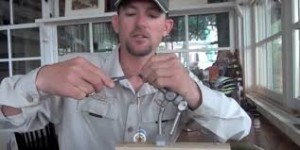Fly Room Basics
By Capt. Charlie Beadon
One of the most relaxing ways to spend the day (other than fishing) is preparing to go fishing, and there is no better way to do this than tying flies. We’re going to focus primarily on tying bass and saltwater flies. These flies are a lot of fun to tie because of their presence, colors and flash. Moreover, you can use them to fish with…who would have thought that fish would eat a bunch of chicken feather tied to the end of a hook.
First let’s look at the tools of the trade. The base tools that you will need are a vice, bobbin, scissors and a hair packer. The vice is used to hold the hook in place while you work. The bobbin holds your thread and allows you to let out only the amount needed at any given time. Good sharp scissors are a must, and finally the hair packer is used to even out animal hair before tying it on the hook.
 Next we need to discuss the various materials that you may use to tie flies. There are hundreds of different materials and they all come in multiple colors, so I am only listing the basics: hackle, buck tail, marabou, flash, chenille, eyes, and synthetics. Hackle consists of various styles of feathers used to make up the tail and body of the fly. Buck tail or deer body hair also used to make up the tail and body of flies. Marabou is the fluffy bottom side of feathers or young feathers, this is used as a body material and works well because it breaths well in the water. In almost all saltwater flies we use some sort of flash (flashaboo, Krystal flash, wing flash). The flash simply mimics the scales of a bait fish. Chenille is used to build the underside of the body of the fly, this give the fly bulk and sometimes flash. We use fake eyes for many flies, some eyes are painted or stuck on and others are tied in giving the fly not only the appearance of eyes but also weight. There are many different types of synthetic materials on the market. Most of these materials simply take the place of natural materials such as hackle and buck tail. There are a few more miscellaneous items that you will need when tying flies. These items would include: various hooks, waxed thread, epoxy, head cement, razor blades, hook sharpener and a good pattern book.
Next we need to discuss the various materials that you may use to tie flies. There are hundreds of different materials and they all come in multiple colors, so I am only listing the basics: hackle, buck tail, marabou, flash, chenille, eyes, and synthetics. Hackle consists of various styles of feathers used to make up the tail and body of the fly. Buck tail or deer body hair also used to make up the tail and body of flies. Marabou is the fluffy bottom side of feathers or young feathers, this is used as a body material and works well because it breaths well in the water. In almost all saltwater flies we use some sort of flash (flashaboo, Krystal flash, wing flash). The flash simply mimics the scales of a bait fish. Chenille is used to build the underside of the body of the fly, this give the fly bulk and sometimes flash. We use fake eyes for many flies, some eyes are painted or stuck on and others are tied in giving the fly not only the appearance of eyes but also weight. There are many different types of synthetic materials on the market. Most of these materials simply take the place of natural materials such as hackle and buck tail. There are a few more miscellaneous items that you will need when tying flies. These items would include: various hooks, waxed thread, epoxy, head cement, razor blades, hook sharpener and a good pattern book.
The following flies are good choices to get started with: wooly bugger, Clouser minnow, Lefty’s deceiver and crazy Charlie’s.
Captain Charlie Beadon
www.hiltonheadfishingadventures.com

